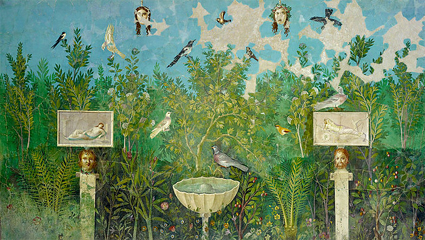“Life and Death in Pompeii and Herculaneum”.
The House of the Golden Bracelet must have been one of the more luxurious homes in the seaside town of Pompeii. The owners, a couple with two small children, were, like many Romans, particularly fond of their hortus, or garden. One of their favourite rooms looked directly out on to its borders and trellises, its garden statuary of bronze and stone, its limpid pools and fountains – and beyond, to a spectacular view of the sea. This room, which only had three walls, was open to the elements and was itself a kind of painted garden, being entirely covered with frescoes of plants rioting in wild profusion and birds depicted with such ornithological precision that they can still be identified today: a pigeon, a jay and a golden oriole perch in the foliage, while a purple swamp hen grumpily stalks the undergrowth.
“The Garden Room” is one of the most remarkable survivals of the ancient world. Transported from Italy and now reconstructed under the dome of the Great Reading Room in the British Museum, the hortus conclusus formed by its three painted walls is perhaps the star exhibit of a stellar new exhibition. Its focus is on the daily lives of the citizens of Pompeii and Herculaneum, rich and poor: noblemen and millionairesses, merchants, freedmen and slaves. Never have so many objects from these two catastrophically destroyed towns of the first century AD been brought together outside Naples itself, and away from the shadow of Vesuvius. The result is a show that reincarnates a distant time and place with stunning immediacy, while constantly serving grim reminders of its end. One of the most affecting items is a wooden rocking-cradle from Herculaneum, instantly carbonised by the ferocious heat of the volcano and therefore startlingly...


